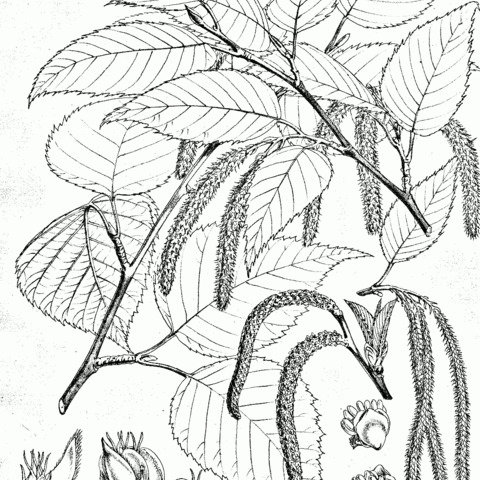Trees to 30 m tall; bark gray, exfoliating. Branchlets densely white villous and resinous glandular. Petiole 1.5-3(-4) cm, densely villous and glandular punctate; leaf blade lanceolate, ovate-lanceolate, or ovate-elliptic, 4-12 × 2.5-5.5 cm, papery, abaxially densely glandular punctate, sparsely villous along veins, bearded in axils of lateral veins, adaxially glabrous, base cuneate, broadly cuneate, or subrounded, rarely subcordate, margin irregularly incurved setiform serrate, apex acuminate or caudate-acuminate; lateral veins 10-13 on each side of midvein. Female inflorescences 3-5 in a raceme, pendulous, narrowly cylindric, 5-10 cm × 4-6 mm when mature; peduncle 2-3 mm, densely yellow villous; bracts ca. 3 mm, densely pubescent and ciliolate, becoming spongy at base, 3-lobed, middle lobe oblong or obtuse, lateral lobes reduced, auriculate. Nutlet obovate, 1.5-2 mm, sparsely pubescent at apex, with membranous wings ca. 2 × as wide as nutlet. Fl. Oct-Jan, fr. Mar-May. 2n = 28.
More
A tree up to 30 m tall. The bark is grey tinted red-brown. It peels off across the trunk in strips. The twigs are purple-red and downy when young. The leaves are 5-10 cm long. They are on red stalks. They have double teeth along the edge. The leaves taper to a fine point. The catkins are in clusters and are 8 cm long. The flowers are male and female separately. The nut is flat with 1 seed.
Can be found in pure stands in secondary forests; in moist evergreen forests on rich, deep loamy soils; dry evergreen hill forests on upper hill slopes and ridges on yellow-red soils; at elevations from 300-2,100 metres.
More
Can be found in pure stands in secondary forests; in moist evergreen forests on rich, deep loamy soils; dry evergreen hill forests on upper hill slopes and ridges on yellow-red soils; at elevations from 300-2,100 metres.
It grows in subtropical forests between 700–2100 m altitude in China. It suits hardiness zones 8-10.
Can be grown by seedlings. Seeds needs stratification.


